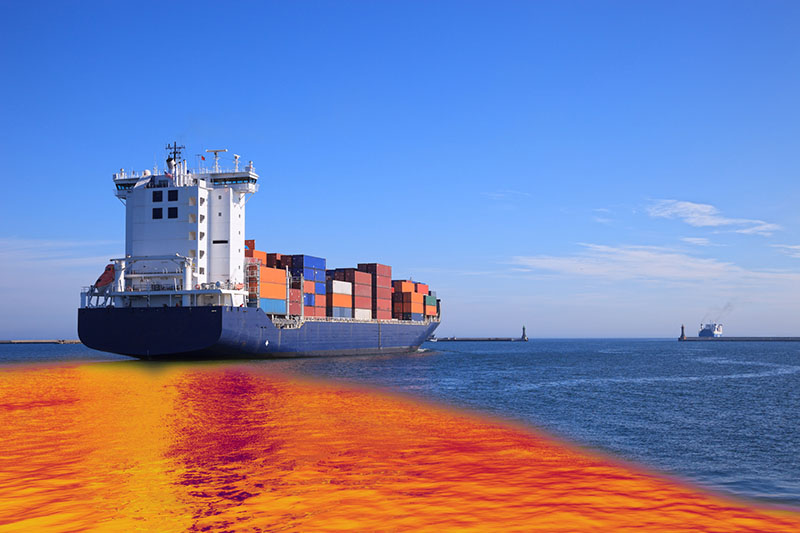Bentz on IMO: IMO-2020, is the sky falling?
This makes a good understanding of how fuel and related costs are managed is critical to effectively managing supply chain performance and cost.
 Brooks Bentz is a 50-year veteran in transportation and supply chain, having spent his career equally on the carrier side (rail, intermodal, truck and 3PL) and in supply chain consulting. He has an MBA in Transportation from the University of Connecticut and served as on a Board Member and an Adjunct Professor in Supply Chain at the University of Denver for 15 years. He is also Chairman of the Rail Industry Advisory Group for the National Railroad Hall of Fame. He divides his time between Stonington, CT, Naples, FL and airplane seats
Brooks Bentz is a 50-year veteran in transportation and supply chain, having spent his career equally on the carrier side (rail, intermodal, truck and 3PL) and in supply chain consulting. He has an MBA in Transportation from the University of Connecticut and served as on a Board Member and an Adjunct Professor in Supply Chain at the University of Denver for 15 years. He is also Chairman of the Rail Industry Advisory Group for the National Railroad Hall of Fame. He divides his time between Stonington, CT, Naples, FL and airplane seats
Kerfuffle is such a marvelous word, describing a commotion typically caused by conflicting views. Back at the end of 2019 we conducted research and interviews seeking to envision what effect the new IMO-2020 rules would have on shippers. The initial commotion stemmed from widely divergent points of view on what the new regulations portended.
The new regulations have now been in effect since January 1, 2020. The predicted effects we reported on at the end of last year fluctuated wildly from very little change to draconian fears of 100% or more increases in the cost of diesel. There were also predictions of large-scale vessel scrapping, slow-steaming and super-slow steaming, all of which were thought to negatively affect supply chain cost and performance.
So, what does it all look like now? Sticking with the maritime theme, there’s been hardly a ripple. As so often happens, other forces intervened and diesel prices have not zoomed into the stratosphere: The global economy is cooling; freight volumes are down; the number of idle ships is growing; there’s a glut of oil on the world market; and the rapid spread of the coronavirus has stifled trade and mobility, with consequently lower demand for fuel.
On top of all this, according to Derik Andreoli, principal at Mercator International, the COVID-19 pandemic has caused global oil demand to further contract at a point when slow global economic growth and trade war tensions have contributed to an oversupplied oil market.
In response, Saudi Arabia had hoped to convince other OPEC producers and Russia to further cut production, but Russia refused to participate, and the Saudis responded by slashing prices and threatening to lift production significantly beginning April. Oil prices have fallen about 30%.
“Weak economic growth, limited heating oil use during a mild winter, well-stocked very low sulfur fuel oil inventories and finally the coronavirus are among factors providing downward price pressure,” says Matt Muenster, senior manager at Breakthrough Fuel. “The global crude oil cushion is growing, stemming from the coronavirus disruption, and will take time to work out of the market. We expect there will be a rebound for crude oil and refined product prices once the coronavirus is contained, but we think that it’s likely that we’ve experienced the highest prices of 2020.”
A part of the prediction for potentially spiking fuel costs was based on a fundamentally strong economy and robust freight market, stemming from what we saw in 2018.
“Prior to the COVID-19 outbreak and response, we were already looking at relatively low economic growth matched with an oversupplied oil market prior to implosion of OPEC’s production cut agreement, now the United States and the world are almost certainly in recession, and the outlook for trade over the first half is decidedly grim.”
—Derik Andreoli, Mercator International
Andreoli argues: “Prior to the COVID-19 outbreak and response, we were already looking at relatively low economic growth matched with an oversupplied oil market prior to implosion of OPEC’s production cut agreement, now the United States and the world are almost certainly in recession, and the outlook for trade over the first half is decidedly grim. At the time of writing (mid-March), oil prices have already fallen to $30 per barrel from $60 at the beginning of the year. Low oil prices are, of course, detrimental to the Kingdom’s main source of export dollars, but the strategy is to choke investment in shale oil development. And the production curves for shale oil wells all but guarantee that if drilling slows significantly, which it will at $30 per barrel because very few new wells would be profitable, U.S. oil production will soon begin to decline. By the third or fourth quarter, production declines could be significant.”
The biggest challenge facing shippers now, and at least for the balance of 2020, will be sorting out the various surcharges being levied by their ocean carriers—who themselves are struggling to figure out how to formulate the right way to charge for fuel.
“The owners are in difficulty as they try to determine meaningful and recoverable fuel surcharges,” says long-time marine industry veteran and chairman of SEA LNG, Peter Keller. “One only needs to look at the significant differences in announcements from the container lines. This will take time to sort out, but shippers and consignees will need to understand the different fuels, consumption and costs so they can negotiate fair surcharges.”
Shippers can begin to make more sense out of the current circumstances by taking the lead in utilizing a more standard methodology for removing distortion and calculating fair, transparent pricing related to their fuel surcharges. This begins by gaining a good grounding in the basics of how marine fuel surcharges are currently derived in terms of different fuel types and costs, vessel sizes, speeds and consumption rates. Only through that exercise can shippers be sure they’re getting a fair and equitable deal.
“If I were a BCO, I would insist on not paying a dime more than the average size vessel would consume under the following assumptions: 85% capacity utilization on the head-haul and an assumption that the average backhaul load rate across the trade lane is achieved,” adds Andreoli. “This way the carrier pays the penalty of not aggressively pursuing loads in both directions. To the extent that the carriers are forced to compete for volumes, the base rates will benefit. Carriers that have larger ships will be rewarded and, more importantly, shippers that get stuck on smaller ships will not be penalized.”
The core theorem is that fuel surcharges are intended as being a pass-through of an uncontrollable expense, not a separate profit center. This makes a good understanding of how fuel and related costs are managed is critical to effectively managing supply chain performance and cost.













